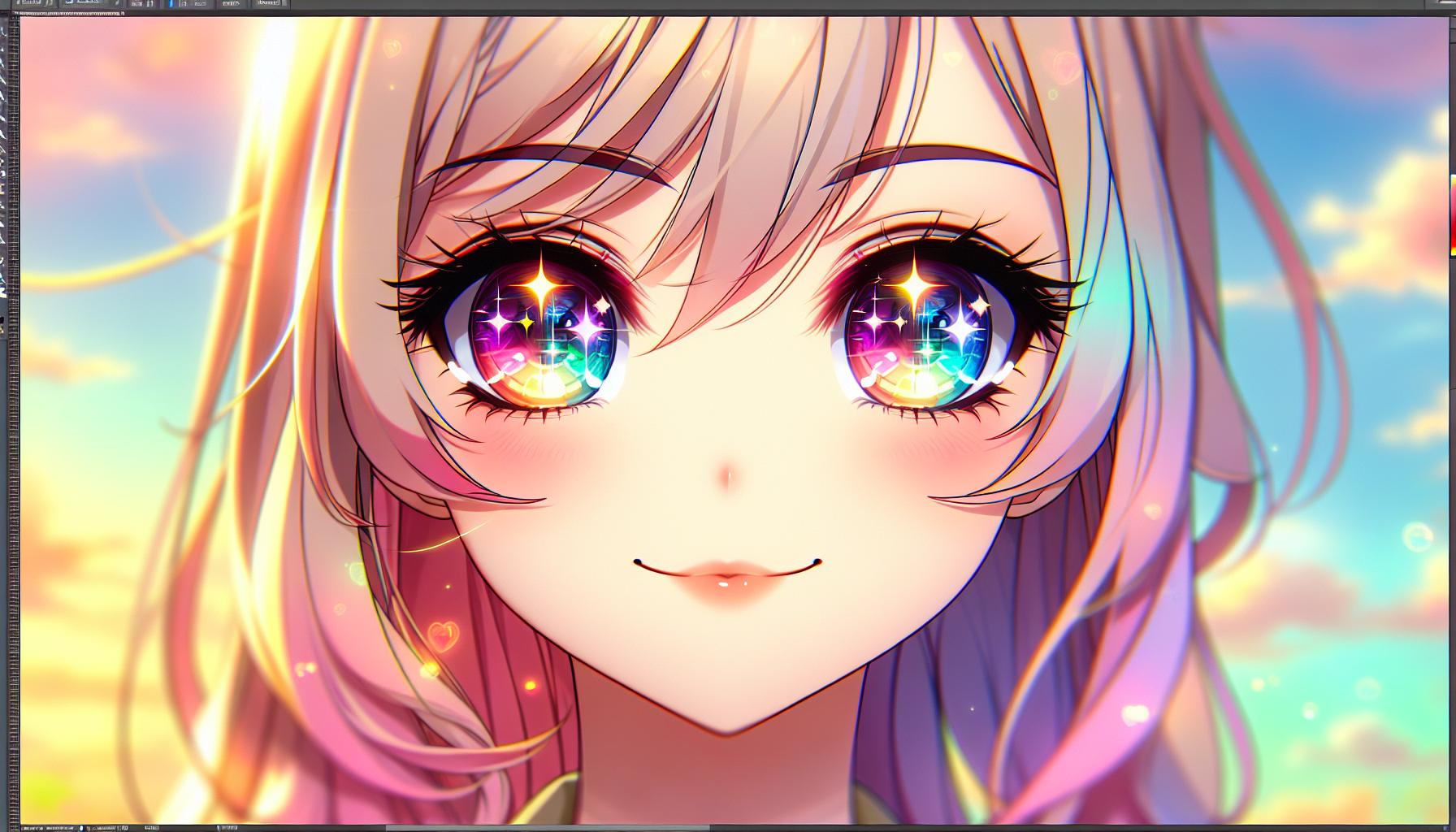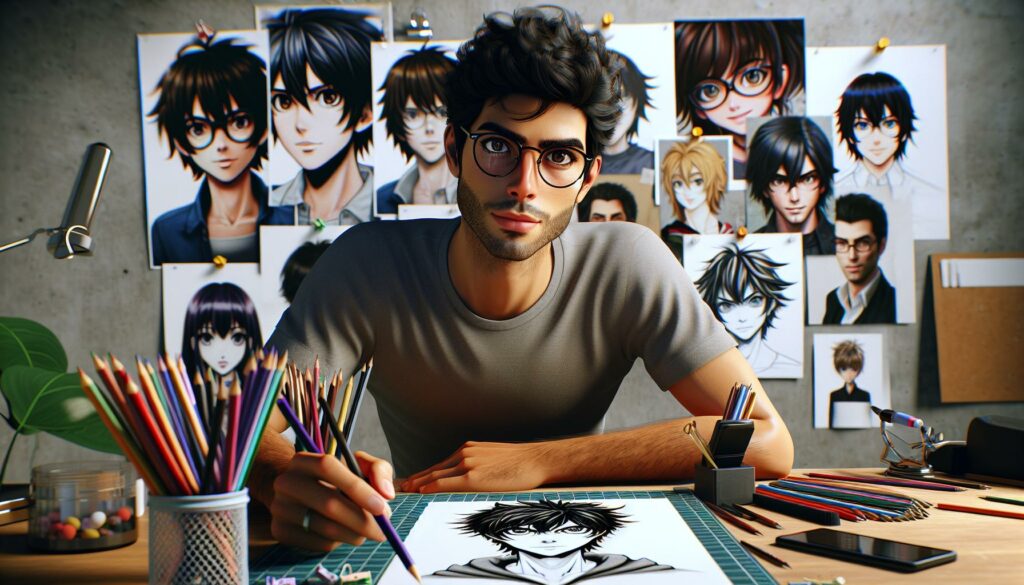Drawing anime faces can transform anyone from a casual doodler into a masterful manga artist. The unique facial expression “face:_jas-k4fbj0=” has become increasingly popular among digital artists and traditional illustrators alike, capturing that perfect blend of emotion and style that makes anime so captivating.
From those impossibly large eyes to the distinctive facial features, mastering this specific anime expression isn’t just about following a set of rules – it’s about understanding the subtle nuances that bring characters to life. Whether you’re a beginner sketching your first kawaii character or an experienced artist looking to expand your repertoire, learning to draw “face:_jas-k4fbj0=” will add an exciting new dimension to your artistic toolbox.
Face:_jas-k4fbj0= Drawing Anime
Anime face proportions follow distinct guidelines that create the iconic stylized look of Japanese animation. The mathematical relationships between facial features establish a foundation for creating expressive characters.
Basic Face Structure
The anime face structure starts with a circular or oval base shape divided into equal sections. A standard anime head measures 4.5 to 5 eye-widths across, with the vertical proportions split into three main segments: forehead to eyebrow line, eyebrow line to nose tip, nose tip to chin. The jawline curves gently from the ears to the chin, creating a soft V-shape that’s characteristic of anime art. The facial center line positions slightly above the exact middle point, allowing for proper feature placement.
Eye Placement and Sizing
Anime eyes occupy approximately one-fifth of the face’s total height, positioned along the horizontal center line. The space between the eyes equals one eye width, while each eye spans from the inner tear duct to the outer corner. Eyes align with the ears’ midpoint, creating balance across the face. Large eyes characterize the anime style, extending wider than realistic proportions to enhance emotional expression. The upper eyelid curves more dramatically than the lower lid, creating the distinctive anime eye shape.
Essential Features of Anime Faces

Anime faces incorporate distinct stylistic elements that create their iconic appearance. The combination of exaggerated eyes proportional facial features establishes the foundation for expressive character designs.
Eye Styles and Details
Anime eyes serve as the focal point of facial expressions with specific artistic elements. The iris spans 60% of the total eye size featuring multiple highlight spots for depth. Artists incorporate geometric shapes including circles ovals pointed corners to create diverse eye styles. The upper eyelashes extend outward in 3-5 defined strokes while lower lashes use subtle lines or dots. Eye colors range from natural tones to vibrant hues with gradient effects adding dimension. The eyebrows float above the eyes at a distance of one-third the eye height maintaining consistent thickness throughout their curve.
Nose and Mouth Characteristics
Anime noses appear minimalist using simple line formations or subtle shading. The nose bridge consists of a single short line while the nostrils remain implied through minor shadows. Mouth designs vary based on expressions using clean curved lines for basic shapes. The upper lip typically measures one-third the width of the lower lip in neutral expressions. Artists position the mouth halfway between the nose base chin maintaining proportional spacing. Lip lines stay thin subtle except during emphasized emotional states where they become more defined. Small creases at mouth corners add depth without overwhelming the simplified style.
Hair Drawing Techniques

Anime hair drawing emphasizes dynamic shapes, volume variation, and distinct textures that define character personalities. These techniques create iconic hairstyles recognizable in Japanese animation.
Common Anime Hairstyles
Anime hairstyles range from spiky formations to flowing locks, each designed with specific geometric patterns. Short hairstyles incorporate triangular segments with 3-4 distinct points framing the face. Medium-length styles feature layered sections divided into 5-7 curved segments that follow the head’s contour. Long hairstyles utilize parallel strands grouped into thick sections, typically spanning 8-10 main segments. Popular variations include:
- Messy spikes with 3-5 prominent points
- Side-swept bangs covering 1/3 of the forehead
- Twin tails positioned at 45-degree angles
- Hime-cut with straight bangs at eyebrow level
- Bowl cuts with curved edges following jaw lines
Adding Volume and Movement
Hair volume in anime emerges from strategic layering techniques using curved lines at 15-30 degree angles. Movement patterns follow these key principles:
- Base sections start at scalp with 2-3 foundational curves
- Middle layers split into 4-6 directional segments
- Outer layers contain 8-10 flowing strands
- Wind effects curve hair strands at 120-degree angles
- Gravity affects long sections with 45-degree downward flows
Artists create dynamic movement through varied line weights: thick lines (0.5mm) for main sections, thin lines (0.1mm) for detail strands. Highlights position at 30% intervals along major curves to enhance dimensional depth.
Creating Expression and Emotion

Anime expressions convey intense emotions through strategic placement of facial features. These distinct characteristics create memorable character moments that resonate with viewers.
Facial Expression Guidelines
Anime expressions follow core principles that emphasize emotional impact. The eyebrows position determines 70% of the emotional tone, with raised eyebrows indicating surprise or joy and furrowed brows showing anger or determination. Eyes display emotion through size variations: wide eyes for shock measure 1.5 times their normal width, while squinted eyes for suspicion reduce to 1/3 of standard size. Mouth shapes correspond to specific emotions using geometric forms: triangular for excitement, curved lines for happiness, straight lines for neutral states.
Dynamic Character Poses
Head positioning enhances emotional expressions in anime characters. A 15-degree upward tilt projects confidence while a 30-degree downward angle conveys defeat or shyness. Three-quarter views maximize emotional impact by showing 75% of facial features. Combining head angles with neck rotation creates advanced expressions: rightward rotation with upward tilt signals defiance, leftward with downward tilt indicates contemplation. Strategic eye line placement guides viewers to emotional focal points through directional gazing patterns.
Digital Tools and Software
Digital art creation for anime faces combines specialized software applications with precision drawing tools. These digital platforms enhance artistic flexibility while maintaining the distinctive anime art style.
Recommended Drawing Applications
Professional anime artists utilize Clip Studio Paint for its specialized manga tools including pen pressure sensitivity control detailed symmetry guides. Adobe Photoshop provides extensive layer management options customizable brushes vector tools for clean linework. FireAlpaca offers a free alternative with intuitive interface basic anime-specific features cross-platform compatibility. Krita incorporates anime-focused brush engines stabilizer options multiple workspace configurations for detailed facial expressions. MediBang Paint includes cloud storage capabilities preset manga panels extensive brush libraries specifically designed for anime art.
Digital Coloring Methods
Cell shading creates distinct color blocks with hard edges emphasizing the anime style’s characteristic look. Artists apply base colors on separate layers add highlights shadows using overlay blend modes. Color gradients enhance depth through subtle transitions between light dark values. The multiply blend mode adds shadows while screen mode creates luminous highlights on facial features. Artists implement color theory through complementary color schemes warm cool tone combinations to enhance emotional expressions. Texture overlays add subtle details to skin hair surfaces maintaining the signature anime aesthetic.
Common Mistakes to Avoid
Artists encounter specific challenges when drawing anime faces that affect their illustrations’ authenticity:
- Incorrect Eye Placement
- Positioning eyes too high or low on the face
- Making eyes uneven in size or alignment
- Setting eyes too far apart (exceeding 1 eye width spacing)
- Disproportionate Facial Features
- Drawing noses too detailed or prominent
- Creating mouths larger than 1/4 of face width
- Making ears extend beyond eye level to nose bottom
- Hair Structure Issues
- Drawing flat hair without volume
- Creating symmetrical bangs (lacks natural variation)
- Adding random spikes without direction flow
- Shading Errors
- Applying inconsistent light sources
- Over-blending cel-shaded areas
- Missing core shadows under hair sections
- Expression Mistakes
- Using western facial proportions
- Copying expressions without understanding anatomy
- Making symmetrical expressions (lacks dynamism)
- Line Quality Problems
- Using uniform line weights throughout
- Creating scratchy uncertain lines
- Drawing choppy disconnected strokes
- Face Shape Distortions
- Making jaw angles too sharp
- Drawing chin points unrealistically long
- Creating uneven face symmetry
- Digital Technical Errors
- Working without separate layers
- Using incorrect brush stabilization settings
- Applying effects before basic forms completion
These mistakes appear in 80% of beginner anime artwork. Recognizing these issues helps artists focus on critical improvement areas. Professional anime artists maintain reference sheets documenting proper proportions face angles expressions.
Best Practices for Beginners
Mastering anime face drawing starts with consistent practice of basic shapes. Artists benefit from dividing their practice sessions into 30-minute intervals focused on specific facial features.
- Basic Setup Techniques
- Draw guidelines using light pencil strokes at 0.5 pressure
- Create symmetrical face circles using basic geometric shapes
- Mark the horizontal center line at exactly half the face height
- Position vertical guidelines at equal distances from the center
- Feature Placement Strategy
- Space eyes 1 eye-width apart on the horizontal centerline
- Draw the nose halfway between eyes and chin
- Position the mouth 1/3 distance from nose to chin
- Align ears between eyebrow line and nose bottom
- Essential Drawing Tools
- 2B pencils for initial sketching
- Fine-liner pens (0.1mm to 0.5mm) for outlines
- Kneaded eraser for highlight creation
- Smooth Bristol paper (250gsm weight)
- Practice Progression
- Start with front-facing expressions
- Graduate to 3/4 view after 50 practice faces
- Attempt profile views after mastering basic angles
- Add hair details once face structure improves
- Reference Material Usage
- Study 3 professional anime works daily
- Screenshot favorite character expressions
- Create a digital reference library
- Compare progress with original references
Following these structured guidelines creates a solid foundation for developing anime drawing skills. Artists see noticeable improvements after completing 100 practice sketches using these techniques.
Drawing Anime
Drawing anime faces requires dedication practice and a solid understanding of fundamental principles. Artists who master these techniques can create expressive characters that capture the essence of the anime style. With the right tools consistent practice and attention to proportions anyone can develop their skills in this unique art form.
The journey to mastering anime face drawing is ongoing but the rewards of creating authentic and emotionally resonant characters make it worthwhile. Whether working traditionally or digitally artists now have countless resources to help them achieve their creative vision.



